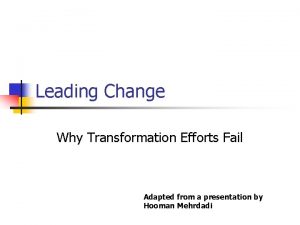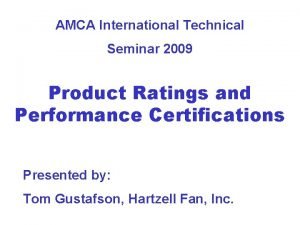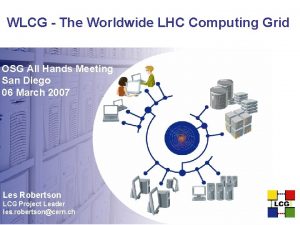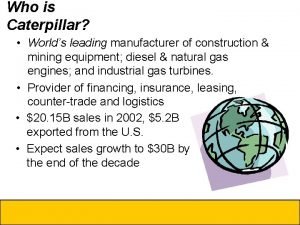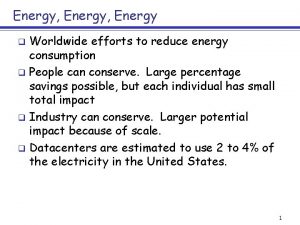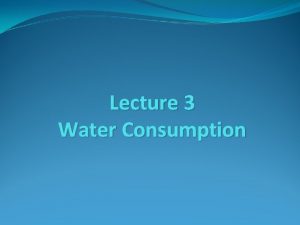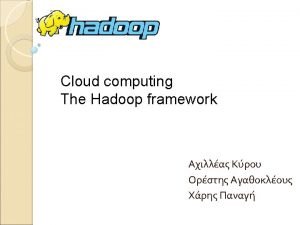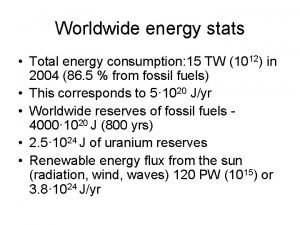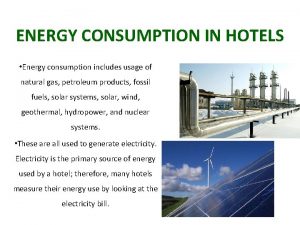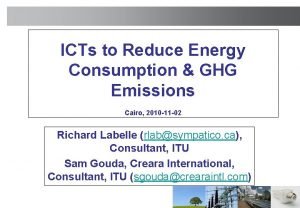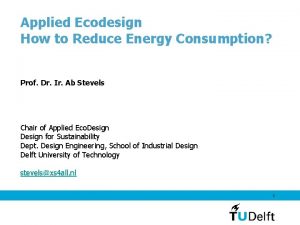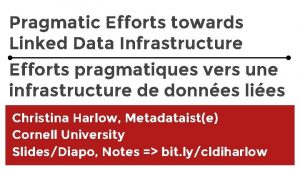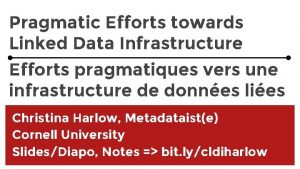Energy Energy Worldwide efforts to reduce energy consumption













![Algorithms q q Can solve via dynamic programming (non-trivial) [Baptiste 2006] Can model more Algorithms q q Can solve via dynamic programming (non-trivial) [Baptiste 2006] Can model more](https://slidetodoc.com/presentation_image/5397a23b2b3b9c4b6f863f76ad88071e/image-14.jpg)


![First Speed Scaling Problem [YDS 95] q Given a set of jobs with m First Speed Scaling Problem [YDS 95] q Given a set of jobs with m](https://slidetodoc.com/presentation_image/5397a23b2b3b9c4b6f863f76ad88071e/image-17.jpg)








![Results for Response Time Plus Energy [BCP 09] Scheduling Algorithm (HDF – highest density Results for Response Time Plus Energy [BCP 09] Scheduling Algorithm (HDF – highest density](https://slidetodoc.com/presentation_image/5397a23b2b3b9c4b6f863f76ad88071e/image-26.jpg)
- Slides: 26

Energy, Energy Worldwide efforts to reduce energy consumption q People can conserve. Large percentage savings possible, but each individual has small total impact q Industry can conserve. Larger potential impact because of scale. q Datacenters are estimated to use 2 to 4% of the electricity in the United States. q 1

Thesis q Energy is now a computing resource to manage and optimize, just like m Time m Space m Disk m Cache m Network m Screen real estate m… 2

Is computation worth it? In April 2006, an instance with 85, 900 points was solved using Concorde TSP Solver, taking over 136 CPU-years, q 250 Watt * 136 years = 300000 KWatt hours q $0. 20 per KWatt hour = $60000 + environmental costs q 3

Random Facts A google search releases between. 2 and 7 grams of CO 2. q Windows 7 + Office 2010 require 70 times more RAM than Windows 98 and Office 2000 to perform the same simple tasks. q By 2020, servers may use more energy than air travel q 4

Power q q What matters most to the computer designers at Google is not speed, but power, low power, because data centers can consume as much electricity as a city m Eric Schmidt, former CEO Google Energy costs at data centers are comparable to the cost for hardware 5

What can we do? q q We should be providing algorithmic understanding and suggesting strategies for managing datacenters, networks, and other devices in an energy-efficient way. More concretely, we can m Turn off computers m Slow down computers (speed scaling) m Are there others? 6

Speed Scaling Technology Dynamic Power ≈ Speed 3 in CMOS based processors 7

Routing can also be green Worldwide more 50 billion k. WH are used per year by data networking, q US Do. E study estimates a 40% reduction in network energy if the energy usage of network components was proportional to traffic. q Routing in an on-chip network for a chip multiprocessor -- As the number of processors per chip grows, interprocessor communication is expected to become the dominant energy component. q 8

Two basic approaches Turn off machines q Slow down/speed up machines q 9

Turning Off Machines q Simplest algorithmic problem: m Given a set of jobs with Ø Processing times Ø Release dates Ø Deadlines m Schedule them in the smallest number of contiguous intervals m Why this problem? Fewer, longer idle periods provide opportunities to shut down the machine 10

Example 11

Example - EDF schedule idle 4 short idle periods idle 12

Example idle 1 long, 1 short interval 13
![Algorithms q q Can solve via dynamic programming nontrivial Baptiste 2006 Can model more Algorithms q q Can solve via dynamic programming (non-trivial) [Baptiste 2006] Can model more](https://slidetodoc.com/presentation_image/5397a23b2b3b9c4b6f863f76ad88071e/image-14.jpg)
Algorithms q q Can solve via dynamic programming (non-trivial) [Baptiste 2006] Can model more complicated situations m m q q Minimize number of intervals Minimize cost, where cost of an interval of length x is min(x, B). (can shut down after B steps). Multiple machines. All solved via dynamic programming On-line algorithms with good competitive ratios don’t exist (for trivial reasons) Competitive ratio = max. I (on-line-alg(I) / off-line-opt(I)) Can also ask about how to manage an idle period 14

Speed Scaling Machines can change their speeds s q Machines burn power at rate P(s) q Computers typically burn power at rate P(s) = s 2 or P(s) = s 3. q Also consider models where P(s) is an arbitrary, non-decreasing function q Can also consider discrete sets of speeds. q 15

Speed Scaling Algorithmic Problems q q q The algorithm needs policies for: m Scheduling: Which job to run at each processor at each time m Speed Scaling: What speed to run each processor at each time The algorithmic problem has competing objectives/constraints m Scheduling Quality of Service (Qo. S) objective, e. g. response time, deadline feasibility, … m Power objective, e. g. temperature, energy, maximum speed Can consider m Minimizing power, subject to a scheduling constraint m Optimizing a scheduling constraint subject to a power budget m Optimizing a linear combination of a (minimization) Qo. S objective and energy 16
![First Speed Scaling Problem YDS 95 q Given a set of jobs with m First Speed Scaling Problem [YDS 95] q Given a set of jobs with m](https://slidetodoc.com/presentation_image/5397a23b2b3b9c4b6f863f76ad88071e/image-17.jpg)
First Speed Scaling Problem [YDS 95] q Given a set of jobs with m Release date rj m Deadline dj m Processing time wj q q Given an energy function P(s) Compute a schedule that schedules each job feasibly and minimizes energy used energy = ∫P(st) dt 17

Toy Example q 2 jobs m Release date 0 m Deadline 2 m Work 2 Power = (1)23 +(1)23 = 16 Power = (. 5)43+ 1. 5(4/3)3 = 35. 6 0 1 2 18

Facts By convexity, each job runs at a constant speed (even with preemption) q A feasible schedule is always possible (run infinitely fast) q 19

Offline YDS Algorithm (1995) § Repeat o Find the time interval I with maximum intensity Ø Intensity § o of time interval I = Σ wi / |I| Where the sum is over tasks i with [ri, di] in I During I Ø speed = to the intensity of I Ø Earliest Deadline First policy o Remove I and the jobs completed in I

YDS Example Release time deadline

YDS Example First Interval Intensity Second Interval Intensity = green work + blue work Length of solid green line

YDS Example § Final YDS schedule o § Height = processor speed YDS theorem: The YDS schedule is optimal for minimizing energy (also for minimizing temperature, or maximum power)

Minimizing linear combinations q Example: m Total response time + α (energy cost) m Assumption: both time and energy can be translated into dollars m E. g. How much am I willing to pay to save one minute? 24

Minimizing Energy + Response Time 1 machine q Jobs have weights a, release dates q Scheduler chooses job to run, and speed for each job q Schedule gives completion times to jobs Cj q Objective is Σj aj(Cj-rj) + ∫t P(st) dt q Algorithm is on-line. q 25
![Results for Response Time Plus Energy BCP 09 Scheduling Algorithm HDF highest density Results for Response Time Plus Energy [BCP 09] Scheduling Algorithm (HDF – highest density](https://slidetodoc.com/presentation_image/5397a23b2b3b9c4b6f863f76ad88071e/image-26.jpg)
Results for Response Time Plus Energy [BCP 09] Scheduling Algorithm (HDF – highest density first). Density is weight/processing time q Speed setting algorithm involves inverting a potential function used in the analysis. q Power function is arbitrary. q Algorithm is (1+ ε)-speed, O(1/ε)-competitive (scalable). q 26
 Mri energy consumption
Mri energy consumption Dynamicresolution android
Dynamicresolution android Contoh refine teknologi ramah lingkungan
Contoh refine teknologi ramah lingkungan Leading change why transformation efforts fail
Leading change why transformation efforts fail Analysing consumer market
Analysing consumer market Anti-corruption efforts
Anti-corruption efforts Advertise noun
Advertise noun Industry versus inferiority
Industry versus inferiority Causes of scarcity
Causes of scarcity Chapter 2 planning your career
Chapter 2 planning your career Match the column endangered species
Match the column endangered species Lesson 3: europe in the muslim world
Lesson 3: europe in the muslim world Wise work and travel
Wise work and travel Worldwide telescope online
Worldwide telescope online Worldwide product division structure
Worldwide product division structure Fsi worldwide
Fsi worldwide Are countrywide and worldwide networks
Are countrywide and worldwide networks Church of god worldwide association
Church of god worldwide association Amca worldwide certified ratings
Amca worldwide certified ratings Worldwide product division structure
Worldwide product division structure Worldwide lhc computing grid
Worldwide lhc computing grid Wipo dl 101
Wipo dl 101 Caterpillar dealers worldwide
Caterpillar dealers worldwide Society for worldwide interbank financial telecommunication
Society for worldwide interbank financial telecommunication Brainpop climate types
Brainpop climate types Church of god worldwide association
Church of god worldwide association Worldwide accounting diversity
Worldwide accounting diversity



